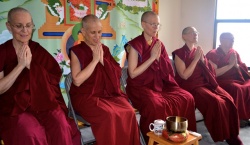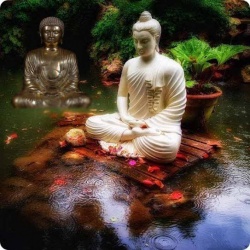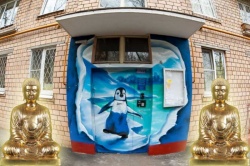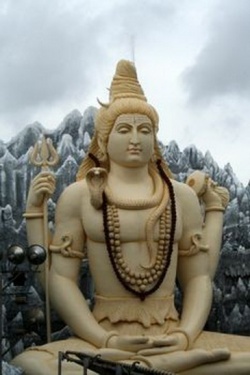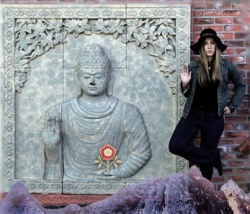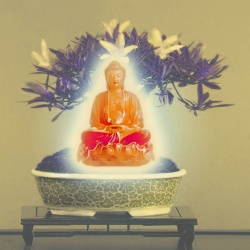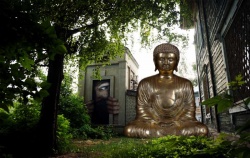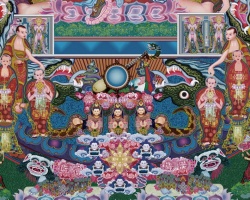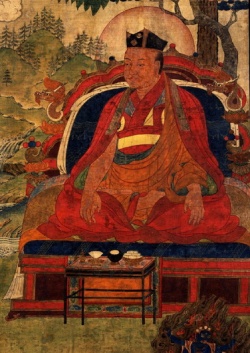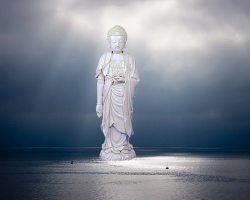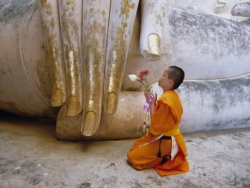The Lineage of Master, Empowerment, and Profound Tantra
by Mi-Kong practitioner
In order to save all sentient beings, Shakyamuni Buddha taught the dharma, the 84,000 dharma ways, as well as the separate esoteric and exoteric schools. The exoteric school seeks refuge in the three jewels, and the esoteric school seeks refuge in the four jewels. Prior to seeking refuge in the three jewels of the exoteric school, an esoteric Buddhist must seek refuge in his tantric master first. Namogurupei, which is Sanskrit, and Lamalaconbusuchuehm, which is Tibetan, both mean “seeking refuge in a master.” Seeking refuge in the four jewels is the first step toward becoming an esoteric Buddhist. This is also the first of the four preliminaries. The second preliminary practice is mandala offering. The third preliminary is prostration, and the fourth preliminary is the mantra of “One Hundred Syllables”. All the above four preliminaries should be practiced 100,000 times as the foundation for cultivating the formal practices. The practitioners who are not qualified for the Inner Tantra Empowerment should concretely build up those foundations before receiving empowerment. Otherwise, the empowerment cannot be fully realized.
Esoteric Buddhism relies on master’s lineage, which is the origin of dharma. The master (guru) represents the three jewels; hence, an esoteric Buddhist must seek refuge in a master first. Master collectively represents Buddha, Dharma, and Sangha, the three jewels. Master is the general appearance of the three jewels, whereas the three jewels are the individual appearance. Master’s thought represents the Buddha jewel, master’s speech represents the dharma jewel, and master’s conduct represents the Sangha jewel. Dharma is taught through master’s three appearances (or gates); hence, master is the first holy representation.
If an esoteric practitioner wants to obtain a particular dharma, he must receive empowerment from his master, because this step is connected to the dharma lineage. Under no circumstances can the unchangeable definition of this step be misunderstood or erroneously interpreted. Tantra teaching (dharma conferring) is an extremely serious matter, and the ceremony is very solemn.
When a practitioner asks for a specific tantra, one should offer a harda (a white silk scarf) and make three requests of his master. Once approved by the master, an auspicious date will be chosen in order to set the mandala. On that day, the master enters his personal deity’s (yidam’s) mandala to conduct the tantra to bless this practitioner. If this ceremony was conducted by a Hutuketu or rinpoche, who would demonstrate the dharma meaning of the Inner Tantra Empowerment, a decision would have to be made first through the defined expressions. The master, who is qualified for blessing (a non-inner tantra master), should at least possess the supernatural power of the great compassion inspiration blessing. And when the master practices this blessing in a gathering, everyone can experience spiritual responses as an assessment. The Dharma King or Tatedonpa should possess the ability of conferring four divisions of the Inner Tantra Empowerments, and any person that lacks one of those four is not qualified to be a saint.
Replacing the Inner Tantra Empowerment ceremony by kungfu—as demonstrated by a magic transformation, penetration of a wall, or flying—is not a real tantra empowerment. Because it is quite easy to be misled by the appearance of supernatural power, an obstacle can be formed. For instance, Master Xian-yi was also confused by supernatural power and boldly libeled the esoteric Buddhism when he did not understand the essence of tantra. After carefully studying tantra later, he profoundly repented his mistakes. Furthermore, the devils and practitioners disobeying Buddhism also embody this kind of kungfu, and it is easy to become a slave of those disobeying Buddhism if the magic power is used as the substitution for empowerment. All the practitioners must be careful to recognize this distinction.
All Inner Tantra Empowerments are conferred by a Gadanchiba or Datedonpa, but not by a Hobilghan. In the process of the empowerment, lights of the Buddhas (the other force) go through the power of the dharma realm and merge with the master’s three gates, including the conduct, speech, and thought. Entering the Samadhi of his Personal Deity (Satyadevata), then, the master transforms himself to possess the characteristics of the deity and conducts his dharma power, i.e., the power of blessing and the power of Samadhi concentration in order to empower his disciple. When a disciple sincerely and confidently accepts, all of the powers will enter the field of the disciple’s mind to provide a pure bodhi (self-mind power) seed capable of development.
At this time, the mind and consciousness of the disciple have completely merged with his Personal Deity’s vivid triple wisdoms (conduct, speech, and thought), and the Vajra seed is formed. The Vajra seed is generated from the perfect integration of the power of others, the power of the dharma realm, the power of the master’s blessing, the power of Samadhi concentration, and the power of the practitioner’s contemplation of the mind. A disciple should continue watering this seed with the power of mantras to maintain the growth of the seed. Unceasingly chant mantras and maintain the effort.
When a practitioner receives a dharma lineage from his master, he should determine if the master obtains this permission from Buddhas, Bodhisattvas, dharma protecting deities, or saint deities for empowerment—this can be seen by the disciple during the Inner Tantra Empowerment. One should constantly practice and keep irrigating in order to correspond one’s three karmas (conduct, speech, and thought) with the master in order to naturally unite with the Personal Deity and receive achievement. A person bestowed by the Inner Tantra Empowerment will receive Buddhahood in this lifetime if that individual can definitely follow the teaching of the dharma.
A practitioner acquiring the Inner Tantra Empowerment is like a baby that is born in a royal family and naturally entitled to be a prince. When he grows up, he will inherit his throne. However, he should be educated and trained by his master during his growth. There have been many adepts in Tibet, and all of them followed the commandment of Buddha (No difference between master and Buddha). The meaning behind this is worth our contemplation. Hence, those adepts in the world must follow “Fifty eulogies for serving a master” that is regarded as an important daily recitation by the practitioners of Tibet.
In Song Dynasty of China, the translation of great Tripitaka preaching Master Zertsern’s Marming Bodhisatva collection, (Yangjou brick bridge’s sutra carving place had this book for circulation) included detailed ways of revering a master. One must learn Yoga’s corresponding fundamental dharma within the Kagyu School, and practitioners should use it for practicing. (Tibetan sutra which covers more than what was translated from Master Zertsern’s collection will be translated later so that readers can comply. There is another “Making Offering to the Master” sutra in Tibetan as well, and it will also be translated by someone.)
In Tibet and Mongolia, a disciple must choose his master, and a master must select his disciple as well. An unqualified disciple is not allowed to receive the great tantra. However, once the relationship between a disciple and a Vajra Master is established, the disciple must respect his master as a Buddha throughout his lifetime. All the teachings from the Vajra Master should be confidently accepted. Even if the disciple is told to walk on mountains of knives and cross seas of fire—or any other requests—he should do so without fear.
If one is asked to move heavy loads and circle the master, one should also do it. This is the most important requirement for an esoteric practitioner. All former Buddhas practiced in this way and got enlightenment in this way. One can verify that through the example of Tibetan patriarch master Tsong Khapa and scriptures. Otherwise, even if a person endeavors in reading the sutra and practicing the dharma, and is profoundly conversant with Sutra and Abhidharma, it is still very difficult to attain Nirvana. Therefore, all the tantric practitioners who desire to reach enlightenment must completely rely on the Vajra Master. Hence, tantra states that one must learn from one’s Vajra Master in order to attain accomplishment. Therefore, we must know that our three karmas (conduct, speech, and thought) must correspond to the three karmas of the Vajra Master.
Arhat Dorje Jiueibo, who could demonstrate supernatural power for the purpose of showing profound instructions, said,
“the critical issue of practicing tantra is to imagine that your master is capable of developing the fundamentals. Paying utmost sincerity to the master is fundamental to the way of becoming a Buddha; however, it is not a normal way of this world. Hence, from a lower stage to an upper stage, there should be a sequence. One’s three karmas must be respectful and should be improved along the sequence. This is to say that one cannot accomplish the super vehicle (Mahayana) in a short period with a vague and careless manner. A master is equal to 100,000 Buddhas. Offering to 100,000 Buddhas is no better than just offering to a pore (or cell) of one’s master. Therefore, one must be respectful in requesting tantra. The three steps of showing respect to a Vajra Master are:
· Do your best to serve the master.
· Have complete confidence in the teachings of the master.
· Treat the master and the Buddha as one and the same.
For the cultivation of tantra, this is the most reverent one.”
Arhat Dorje Jiueibo further said, “When a master practices tantra, 100,000 Buddhas come and circle him clockwise three times and merrily praise him with a courtesy gesture because this master addresses or practices this tantra in the same manner as a Buddha.” The merit and virtue of offering a mouthful of food to a master are peerless. Since a master possesses countless merits and virtues when he becomes the ferry for all sentient beings, the merit and virtue of an offering to a master are also countless.
From the above instructions, one should have a complete understanding of the methods of revering a master. Upon investigation, one finds out that there are many great adepts in Tibet and Mongolia, and one can easily see that people give up all their property and possessions as an offering to their masters. Therefore, if practitioners could not do their best to offer their three karmas to their master—an offering more precious than money and articles, then one could never receive the fruits from practicing the tantra. Hence a practitioner, who is seeking tantra, must sincerely and respectfully make offering to one’s master. Otherwise, the relationship is improper and one cannot receive any benefit.
According to the rules, tantra practitioners should never associate, work, or have meals with vicious persons, and should strictly keep the secret of the tantra. The Three Congregation Pure Commandments are the basis of all precepts. Never indulge in heterodox practices or adhere to beliefs disobeying the teaching of the Buddhas; otherwise, you cannot receive the spiritual response and benefit while practicing the tantra.
The exoteric or esoteric sutras taught by Buddha cannot all be recited without oral transmission from a master. Furthermore, the tantra rituals and rules are even more restricted. Tantra’s various oral directions, especially the seed words which are visualized, and mudras, must be taught by a master in a mandala. Profound tantra, such as the method of the Inner Empowerment, cannot be written as a record and cannot be released so the uninitiated will know. After practicing at a certain level, one would visualize various realms under which, one cannot distinguish a Buddha from a demon and must ask one’s master for recognition. Otherwise, one would be taking a huge risk and may become the prey of the devil.
There are fundamental and conditional masters. The conditional masters are the individuals—possessing a great knowledge—that would be asked about any dharma, a rhyme of a sutra, or even a word and frequently gets together with a disciple. The fundamental master teaches the tantra and confers the tantra empowerment. If one receives the Inner Tantra Empowerment under the power demonstrated by the dharma protecting deity and accepts the tantra teaching from the master, this master is a Vajra fundamental master. The master’s picture must be offered at the center of the mandala without any violation, and one must view the master and Buddha without any difference. Many other secret meanings are not suitable for wide dissemination because you, the reader, have not yet received empowerment.
All tantra practitioners know that tantra is based on the Vairocana sutra and Diamond Crown sutra, which establishes ten kinds of minds to collectively govern all other minds, and constructs the mandala. A mutual correspondence through the three secrets of the conduct, speech, and thought is established between a disciple and the master (later referred as “correspond”) in order to transform a regular person to a saint, an action only known to Buddha. Moreover, the Great Perfection is the utmost tantra in the unexcelled yoga and exceeds the realm of “cultivationless yoga.”
However, most disciples only know part of it; when hearing that a rinpoche is teaching the Great Perfection, one immediately takes him as a reincarnation of the Tathagata Buddha and carefully follows his teachings to cultivate oneself. Actually, this is a mistake; dharma has a sequence just like stairs, but cannot be taken as large or small dharma achievements. Any dharma of the four yogas has a crucial difference, and the distinguishing superiority is based on Outer and Inner Tantra. If one receives the Outer Empowerment to practice the Great Perfection, then this is done without the effect of the Inner Empowerment.
Although one can attain some achievement, it is impossible to achieve a quick, superior state of realization. However, if one receives the Inner Empowerment to practice the Great Perfection, then one can achieve a quick, incomparable success with the attendant supernatural power and wisdom to become a Buddha in this lifetime. Therefore, tantra’s superiority does not depend on the levels of dharma but on the method taught through the Inner Tantra Empowerment and through correspondence with the three karmas. From what has been described above, we, the disciples, must assess the qualification of a master, recognize the traces of the Inner Tantra and never listen to or follow the wrong person.
The above description is stated as the qualifications for a master. One, who is the Outer Tantra master, must command the sutra and tantra, possess five sciences (or fields of studies), continue the dharma lineage to teach sentient beings and receive the Vajra Acarya position.
For an Inner Tantra master, in addition to the above conditions, one must possess the mandala power to confer the Inner Tantra Empowerment.
As a Dharma King or a Datedonpa of a school, he or she must possess the four divisions of the Inner Tantra Empowerment in addition to the criteria stated above. In short, a Dharma King or a Datedonpa must be communicable with saints; hence, one must not rely on superficial visualizations to recognize a Gadanchiba, and should not follow a so-called great rinpoche arbitrarily. The four divisions of empowerments are:
The expression of the Vajra Samaya Inner Empowerment is the Vajra scepter that is put on the dharma book either suddenly emits the Samaya fire, which can burn everything but the dharma book under the Vajra, or the Vajra’s weight changes from a few pounds to tens of thousands of pounds. A disciple prepares a peacock’s feather, wood pillar and board for the Auspicious Selection Inner Empowerment. The selection of cause and condition is demonstrated by the dharma protecting deities’ supernatural power, not by the master. Four major expressions of the Auspicious Selection Empowerment are:
· Auspicious flying empowerment: The expression is demonstrated as the master gently casts the peacock’s feather that flies 100 feet away and is held straight on top of the disciple’s head as the sign of empowerment by the dharma protecting deity, who, in turn, flies on a cloud to approach the disciple.
· Flying into mandala empowerment: A disciple sits on the self-prepared, wood board outside the mandala and the board suddenly flies the disciple into the center of the mandala for empowerment.
· Peacock’s feather selection empowerment: The dharma protecting deities attach themselves to the lifeless peacock’s feather which becomes alive to demonstrate a supernatural power on the wood board and cannot be affected by the disciple. The disciple can watch the dharma protecting deities (or saints) with solemn appearance as they work for the empowerment.
· The Dharma Wheel Saints Communicable Inner Empowerment must let a disciple see the golden dharma wheel in the Nyingma School to demonstrate the boundless power, to behave as a saint and to select the condition for predicting one’s life and death. The Kagyu School uses the silver dharma wheel, the Gelukpa School also uses the golden dharma wheel and the Sakya School uses the three-color dharma wheel. All of them can demonstrate supernatural power that cannot be manipulated by the master.
The disciple who wants to exceed the utmost Great Perfection realm has to practice the Empty-and-joyful (Hey) Vajra of red-white bodhi to enter Buddhahood in this lifetime as well as receive the utmost grand Nectar Empowerment. The utmost grand Nectar Empowerment must be conferred by a Gadanchiba and is expressed as an empty bowl that is used to invite Buddhas to descend the nectar falling from sky into the bowl that has been covered by a disciple. The western Buddha descends the red nectar, the eastern Buddha descends the white nectar, the southern Buddha descends the yellow nectar, the northern Buddha descends the green nectar, the central Buddha descends the blue nectar and the Five Dhyani Buddhas descend the five-color nectar.
The descent nectar is not an element recognized in this world. When one watches it horizontally and tries to touch it, this solid matter cannot be sensed; but, when viewing vertically from the top as well as touching it, one can sense its existence. After receiving this supreme Buddha Bestowed Nectar Inner Empowerment, if one corresponds one’s three karmas with the master and practices accordingly, the incredible achievement will be peerless and this person will enter Buddhahood during this lifetime.
If not qualified for empowerment, the blessing of nectar can increase one’s lifetime to 100 and more years; if two blessings are held, then one’s lifetime can be definitely increased to 200 years. If one does not possess the above four divisions of the Inner Empowerment, even if one’s speech is fantastic, then he is just a cultivating, great virtuous one (an in-house practitioner) and not the reincarnation of a Gadanchiba. (Practitioners can contemplate why one does not possess the four divisions of the Inner Empowerment, behaving like a normal great virtuous one, if he is a Gadanchiba or reincarnation of a Buddha or Bodhisattva?) Hence, the decision based on either casting a wooden dart to a selected green fruit or the auspicious grass dream for the Outer Empowerment is nothing in comparison to those of the Inner Empowerment.
To recognize the difference between true or false, one should never be confused by the outside appearance and people’s gossip. Do not misconceive the false as the true and mistake the Outer Empowerment as the Inner Empowerment. The tantra has been popular in the past few decades, and there are qualified masters for the Inner Empowerment. Practitioners must carefully look for them, follow them, and respectfully ask them for empowerment. If one corresponds the three karmas with the master and practices accordingly, then one can surpass a normal life and become a saint, a Mahayana compassionate person with the supernatural power and wisdom light.
The description above is presented to inform practitioners about the expression of the Inner Empowerment; however, the Inner Empowerment is for people with the utmost Mahayana’s faculty to enter Buddhahood in the current lifetime and not for regular practitioners. Moreover, the saint that can confer the Inner Empowerment is very rare; it is hard to find one in 10,000 great rinpoches. Hence, practitioners should never look down upon the Outer Empowerment and its practicing that were also handed down by Buddhas and possess the tantra blessing power. If one corresponds one’s three karmas with the teachings of the master and practices accordingly, then one can get out of reincarnation. The Outer Empowerment also contains four divisions:
Practitioners can assess master’s qualifications and follow accordingly. What is described above is based on my personal experience in Tibet during the past several years. It provides in-depth tantra and its associated meanings that are carried out by many great virtuous ones and is the path that the saints have followed. It contains the truth and there is no other alternative. If one has the opportunity to obtain “The Must-Read Chapter Describing The Connection Between The Master And Disciple” and studies it, then one would understand the tantra as described above. Furthermore, practitioners must study the “Beneficial Effect Thesis” that is best taught by Gadanchiba Tsungsheng and the Great Hobilghan Larnchaw.
Chairman Eulongshiar said, “Dharma King Tsungsheng has opened the secret meaning to accomplished tantric practitioners including Vajra Continent, Janyang Chingjeng Hanpo, Pobarncar and other masters. He mentioned that an anonymous, saint master would emerge a few decades later, and would be educated by him to be a most distinguished person, proficient in Tripitaka, commanding the five sciences transcending the superlative, harmonizing the Sutra and Tantra teachings like a shining moon, shaking the Saha Land (the earth) with an awesome reputation, receiving the Gadanchiba title, conducting many virtuous deeds and accurate tantra, teaching in a concise and thorough manner for beneficial effect and conferring the perfect Inner Empowerment.”
From the above described cause and condition, the anonymous, saint master will emerge and his teaching on “Beneficial Effect Thesis” will be the best if practitioners have the opportunity to obtain it. Unfortunately, the name of the reincarnated, anonymous, saint master and the temple that he will live in are still unknown. He must have appeared as a Dharma King or a great monk in my imagination. Practitioners who want to recognize him accurately can use the assessment on harmonizing the Sutra and Tantra teachings, commanding the five sciences, and conferring four divisions of the Inner Empowerment to determine the reincarnation of this saint.
Especially, I want to remind practitioners here that they should never try the great couple tantra and actually indulge in sex with girls—a demon behavior! I heard lately that some evil young men did not have any supernatural power and the females did not practice either; and they never received the unexcelled inner tantra, Buddha Bestowed Nectar Inner Empowerment. How can they be qualified as the Buddha father and mother? They dare to blindly and boldly have sex using the couple tantra as the excuse! What a pity!
These evil men dare to indulge in short-period fun without considering the resulting consequence—hell, which is equivalent to shooting an arrow and ignoring where it lands. They have lost their mind and even death cannot make up for their mistakes. They can never be forgiven! There are even blind masters, who erroneously teach the couple tantra generation by generation, destroying practitioners’ characters and wisdom; their mistakes are unforgivable! Besides, those masters have never heard of and never touch the Inner Tantra realm, and many of them are pretending to be rinpoches and Vajra Masters in China and Tibet. How will this kind of devil escape from hell?
Therefore, I want to especially inform those evil young men that have committed the above described mistakes to first repent and then request that they go to the Pure Land after death. Sincerely practice the commandments, concentration and wisdom, remove the concupiscence, anger and ignorance, use the great compassion as the basis to practice ten virtuous deeds, recite Buddha’s name and visualize Buddha concentratively, and make a genuine wish to go to the Superlative Joy after death; there is really no other alternative. So never practice beyond one’s limitation to irrationally acquire the unexcelled tantra to enter Buddhahood in this lifetime. If one is qualified, then one will have the opportunity to acquire the profound tantra for entering Buddhahood in this lifetime. If one is foolish and ignorant and does not want to follow the book True Traces of Tibetan Tantra in order to locate a saint to follow, then it is impossible to have the opportunity. If one maintains the ignorance without awareness, then one will become a devil.
The above is my sincere description. May the intelligent of sentient beings in the ten realms recognize my humble sincerity; that is my best wish. I burn the joss sticks and prostrate myself four times.
